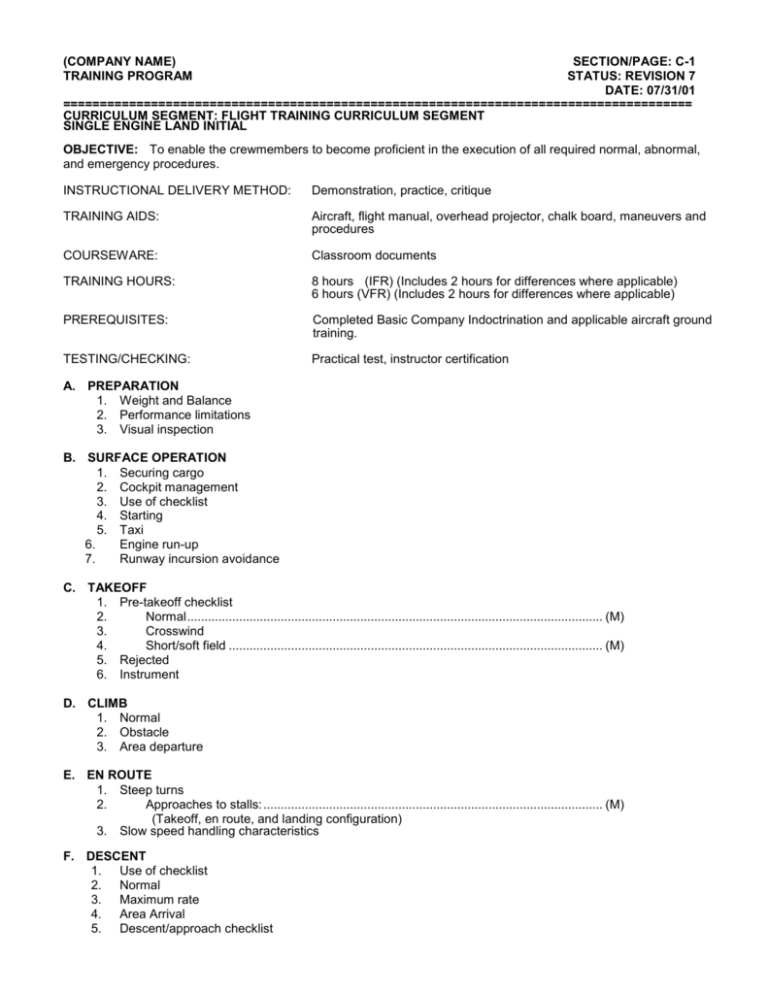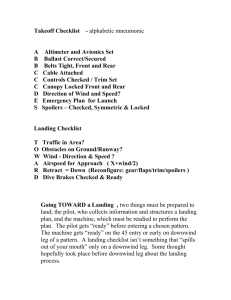Section c - Atlas Aviation
advertisement

(COMPANY NAME) TRAINING PROGRAM SECTION/PAGE: C-1 STATUS: REVISION 7 DATE: 07/31/01 ====================================================================================== CURRICULUM SEGMENT: FLIGHT TRAINING CURRICULUM SEGMENT SINGLE ENGINE LAND INITIAL OBJECTIVE: To enable the crewmembers to become proficient in the execution of all required normal, abnormal, and emergency procedures. INSTRUCTIONAL DELIVERY METHOD: Demonstration, practice, critique TRAINING AIDS: Aircraft, flight manual, overhead projector, chalk board, maneuvers and procedures COURSEWARE: Classroom documents TRAINING HOURS: 8 hours (IFR) (Includes 2 hours for differences where applicable) 6 hours (VFR) (Includes 2 hours for differences where applicable) PREREQUISITES: Completed Basic Company Indoctrination and applicable aircraft ground training. TESTING/CHECKING: Practical test, instructor certification A. PREPARATION 1. Weight and Balance 2. Performance limitations 3. Visual inspection B. SURFACE OPERATION 1. Securing cargo 2. Cockpit management 3. Use of checklist 4. Starting 5. Taxi 6. Engine run-up 7. Runway incursion avoidance C. TAKEOFF 1. Pre-takeoff checklist 2. Normal ........................................................................................................................ (M) 3. Crosswind 4. Short/soft field ............................................................................................................ (M) 5. Rejected 6. Instrument D. CLIMB 1. Normal 2. Obstacle 3. Area departure E. EN ROUTE 1. Steep turns 2. Approaches to stalls: .................................................................................................. (M) (Takeoff, en route, and landing configuration) 3. Slow speed handling characteristics F. DESCENT 1. Use of checklist 2. Normal 3. Maximum rate 4. Area Arrival 5. Descent/approach checklist (COMPANY NAME) TRAINING PROGRAM SECTION/PAGE: C-2 STATUS: REVISION 3 DATE: 03/15/96 ====================================================================================== G. APPROACHES 1. VFR procedures ......................................................................................................... (M) a. Normal b. Accuracy 2. IFR precision approaches ............................................................................................ (M) a. ILS b. ILS/DME c. PAR 3. IFR nonprecision approaches (AS APPLICABLE) ..................................................... (M) a. NDB b. VOR c. LOC backcourse procedures d. ASR procedures e. Circling approach f. Missed approach .............................................................................................. (M) g. SDF/LDA procedures h. RNAV approaches I. LORAN C approaches j. GPS approaches NOTE: At least one MAP must be a complete approved procedure. i. From precision approach ii. From nonprecision approach H. LANDINGS 1. Normal 2. Spot 3. With simulated powerplant failure 4. From precision instrument approach 5. Crosswind 6. Short/soft field 7. With pitch not trimmed 8. Rejected landing (Go-around) 9. Use of Landing Checklist I. AFTER LANDING 1. Parking 2. Emergency evacuation 3. Shutdown checklist J. OTHER FLIGHT PROCEDURES DURING ANY AIRBORNE PHASE 1. Holding 2. Ice accumulation on airframe 3. Air hazard avoidance 4. Windshear/microburst 5. Use of emergency checklist (COMPANY NAME) TRAINING PROGRAM SECTION/PAGE: C-3 STATUS: REVISION 3 DATE: 03/15/96 ====================================================================================== K. SYSTEMS PROCEDURES DURING ANY AIRBORNE PHASE (Normal, abnormal, alternate) 1. Fuel and oil 2. Electrical 3. Hydraulic 4. Flight controls 5. Anti-icing and deicing systems 6. Stall warning devices/stall avoidance devices 7. Flight instrument system malfunction 8. Communications equipment 9. Navigation equipment 10. Pneumatic/ pressurization 11. Air conditioning 12. Autopilot 13. Flight management guidance systems and/or automatic or other approach and landing aids 14. Airborne weather radar 15. Use of checklists L. SYSTEMS PROCEDURES TRAINING DURING ANY AIRBORNE PHASE (Emergency) 1. Aircraft fires 2. Smoke control 3. Powerplant malfunctions 4. Electrical, hydraulic, pneumatic systems 5. Flight control systems malfunction 6. Landing gear and flap systems malfunction 7. Emergency descent 8. Engine out (Forced Landing) 9. Use of emergency checklists (COMPANY NAME) TRAINING PROGRAM SECTION/PAGE: C-4 STATUS: REVISION 7 DATE: 07/31/01 ====================================================================================== CURRICULUM SEGMENT: FLIGHT TRAINING CURRICULUM SEGMENT SINGLE ENGINE LAND TRANSITION OBJECTIVE: To enable the crewmembers to become proficient in the execution of all required normal, abnormal, and emergency procedures. INSTRUCTIONAL DELIVERY METHOD: Demonstration, practice, critique TRAINING AIDS: Aircraft, flight manual, overhead projector, chalk board, maneuvers and procedures COURSEWARE: Classroom documents TRAINING HOURS: 6 hours (IFR) (Includes 2 hours for differences where applicable) 5 hours (VFR) (Includes 2 hours for differences where applicable) PREREQUISITES: Completed basic company indoctrination and applicable aircraft ground training, and qualified in company aircraft TESTING/CHECKING: Practical test, instructor certification A. PREPARATION 1. Weight and balance 2. Performance limitations 3. Visual inspection B. SURFACE OPERATION 1. Securing cargo 2. Cockpit management 3. Use of checklist 4. Starting 5. Taxi 6. Engine run-up 7. Runway incursion avoidance C. TAKEOFF 1. Pre takeoff checklist 2. Normal ........................................................................................................................ (M) 3. Crosswind 4. Short/soft field ............................................................................................................ (M) 5. Rejected 6. Instrument D. CLIMB 1. Normal 2. Obstacle 3. Area departure E. EN ROUTE 1. Steep turns 2. Approaches to stalls: .................................................................................................. (M) (Takeoff, en route, and landing configuration) 3. Slow speed handling characteristics 4. Collision Avoidance F. DESCENT 1. Use of checklist 2. Normal 3. Maximum rate 4. Area Arrival 5. Descent/approach checklist (COMPANY NAME) TRAINING PROGRAM SECTION/PAGE: C-5 STATUS: REVISION 3 DATE: 03/15/96 ====================================================================================== G. APPROACHES 1. VFR procedures ......................................................................................................... (M) a. Normal b. Accuracy 2. IFR precision approaches ............................................................................................ (M) a. ILS b. ILS/DME c. PAR 3. IFR nonprecision approaches (As applicable) ........................................................... (M) a. NDB b. VOR c. LOC backcourse procedures d. ASR procedures e. Circling approach f. Missed approach ............................................................................................... (M) g. SDF/LDA procedures h. RNAV approaches I. LORAN C approaches j. GPS approaches NOTE: At least one MAP must be a complete approved procedure. i. From precision approach ii. From nonprecision approach H. LANDINGS 1. Normal 2. Spot 3. With simulated powerplant failure 4. From precision instrument approach 5. Crosswind 6. Short/soft field 7. With pitch not trimmed 8. Rejected landing (Go around) 9. Use of landing checklist I. AFTER LANDING 1. Parking 2. Emergency evacuation 3. Shutdown checklist J. OTHER FLIGHT PROCEDURES DURING ANY AIRBORNE PHASE 1. Holding 2. Ice accumulation on airframe 3. Air hazard avoidance 4. Windshear/microburst 5. Use of emergency checklist (COMPANY NAME) TRAINING PROGRAM SECTION/PAGE: C-6 STATUS: REVISION 3 DATE: 03/15/96 ====================================================================================== K. SYSTEMS PROCEDURES DURING ANY AIRBORNE PHASE (Normal, abnormal, alternate) 1. Fuel and oil 2. Electrical 3. Hydraulic 4. Flight controls 5. Anti-icing and deicing systems 6. Stall warning devices/stall avoidance devices 7. Flight instrument system malfunction 8. Communications equipment 9. Navigation equipment 10. Pneumatic/ pressurization 11. Air conditioning 12. Autopilot 13. Flight management guidance systems and/or automatic or other approach and landing aids 14. Airborne weather radar 15. Use of Checklists L. SYSTEMS PROCEDURES TRAINING DURING ANY AIRBORNE PHASE (Emergency) 1. Aircraft fires 2. Smoke control 3. Powerplant malfunctions 4. Electrical, hydraulic, pneumatic systems 5. Flight control systems malfunction 6. Landing gear and flap systems malfunction 7. Emergency descent 8. Engine out (Forced landing) 9. Use of emergency checklists (COMPANY NAME) TRAINING PROGRAM SECTION/PAGE: C-7 STATUS: REVISION 7 DATE: 07/31/01 ====================================================================================== CURRICULUM SEGMENT: FLIGHT TRAINING CURRICULUM SEGMENT MULTI ENGINE PISTON AND TURBO PROP POWERED/TRANSITION (Develop curriculum segment for each make and model) OBJECTIVE: To enable the crewmembers to become proficient in the execution of all required normal, abnormal, and emergency procedures. INSTRUCTIONAL DELIVERY METHOD: Demonstration, practice, critique TRAINING AIDS: Aircraft Flight Manual, overhead projector, chalk board, maneuvers and procedures COURSEWARE: Classroom documents TRAINING HOURS: 10 hours (IFR) Piston powered 8 hours (VFR) Piston powered PREREQUISITES: Qualified in Company single or multi-engine airplane and completed appropriate aircraft ground training TESTING/CHECKING: Practical test, instructor certification 12 hours (IFR) Turbo prop powered 10 hours (VFR) Turbo prop powered A. PREPARATION 1. Visual inspection 2. Pre-taxi procedures 3. Performance limitations B. SURFACE OPERATION 1. Cockpit management 2. Securing cargo 3. Starting 4. Taxi 5. Pre-takeoff checks 6. Runway incursion avoidance C. TAKEOFF 1. Normal ........................................................................................................................ (M) 2. Crosswind 3. Short/soft field ............................................................................................................ (M) 4. Powerplant failure before Vmc (rejected) 5. Powerplant failure after Vmc 6. Lower than standard minimum (Instrument) 7. Use of take off checklist D. CLIMB 1. Normal 2. One-engine inoperative ............................................................................................... # 3. Area departure E. EN ROUTE 1. Steep turns 2. Approaches to stalls: ................................................................................................... (M) (Takeoff, en route, and landing configuration) 3. Powerplant shutdown and restart 4. Slow speed handling characteristics 5. With a powerplant inoperative 7. Vmc demonstration and recovery 8. Collision avoidance F. DESCENT 1. Normal 2 Maximum rate 3. Area arrival 4. Descent/approach checklist (COMPANY NAME) TRAINING PROGRAM SECTION/PAGE: C-8 STATUS: REVISION 3 DATE: 03/15/96 ====================================================================================== G. APPROACHES 1. VFR procedures ............................................................................................................ (M) a. Normal b. With flap malfunction ....................................................................................... (M) 2. a. b. c. 3. IFR precision approaches ............................................................................................ (M) ILS/normal ILS/one-engine inoperative PAR IFR nonprecision approaches ...................................................................................... (M) NDB/normal VOR/normal c. Nonprecision approach one-engine inoperative ............................................ # d. LOC backcourse procedures e. ASR procedures f. Circling approach ........................................................................................... (M) g. SDF/LDA procedures h. RNAV approach I. LORAN C procedures j. GPS approach k. Missed approach ........................................................................................... (M) NOTE: At least one MAP must be a complete approved procedure i. From precision approach ii. From nonprecision approach iii. With a powerplant failure a. b. H. I. LANDINGS 1. Normal 2. With pitch not trimmed 3. From precision instrument approach 4. From precision instrument approach with most critical engine inoperative 5. With flap malfunction 6. Crosswind 7. Short/soft field 8. Use of reverse thrust 9. Rejected landing (Go-around) 10. Use of landing checklist AFTER LANDING 1. Parking 2. Emergency evacuation 3. Use of shutdown checklist J. OTHER FLIGHT PROCEDURES DURING ANY AIRBORNE PHASE 1. Holding 2. Ice accumulation on airframe 3. Air hazard avoidance 4. Windshear/microburst (COMPANY NAME) TRAINING PROGRAM SECTION/PAGE: C-9 STATUS: REVISION 3 DATE: 03/15/96 ====================================================================================== K. SYSTEMS PROCEDURES DURING ANY AIRBORNE PHASE (Normal, Abnormal, Alternate) 1. Pneumatic pressurization 2. Air conditioning 3. Fuel and oil 4. Electrical 5. Hydraulic 6. Flight controls 7. Anti-icing and deicing systems 8. Autopilot 9. Stall warning devices, stall avoidance devices, and stability augmentation systems 10. Airborne weather radar 11. Flight instrument system malfunction 12. Communications equipment 13. Navigation equipment 14. Use of appropriate checklists L. SYSTEMS PROCEDURES TRAINING DURING ANY AIRBORNE PHASE (Emergency) 1. Aircraft fires 2. Smoke control 3. Powerplant failure/fire 4. Electrical, hydraulic, pneumatic systems 5. Flight control systems malfunction 6. Landing gear and flap systems malfunction 7. Air hazard avoidance 8. Windshear/microburst 9. Emergency descent .............................................................................................................. # 10. Use of emergency checklists and memory items






